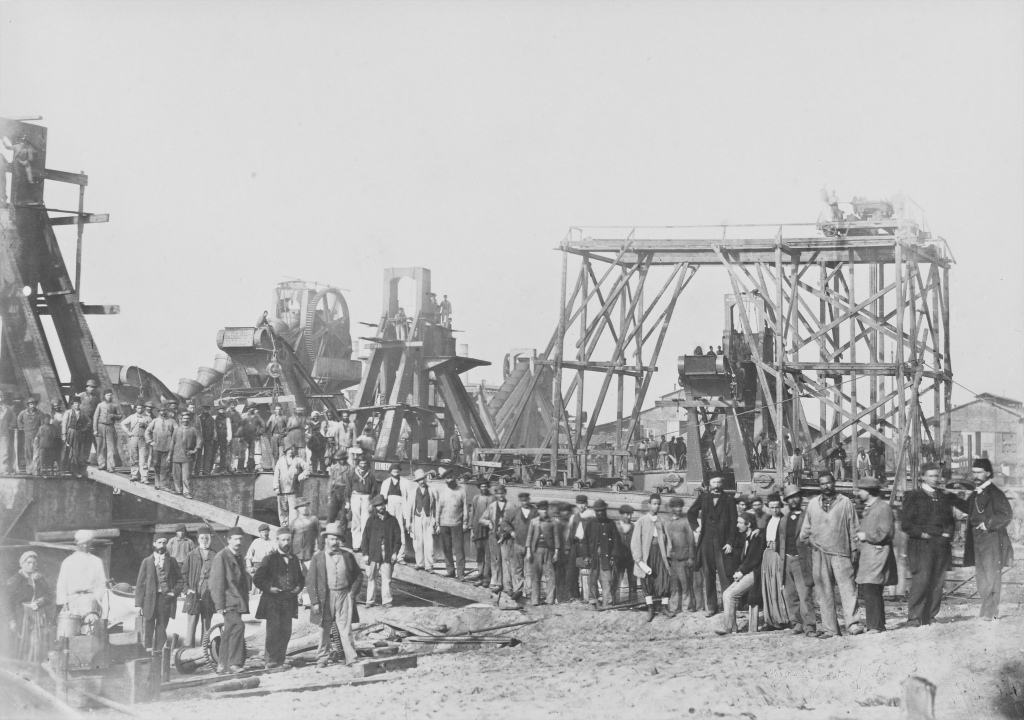
The Suez Canal is a sea-level waterway in Egypt, connecting the Mediterranean Sea to the Red Sea through the Isthmus of Suez. Constructed by the Suez Canal Company between 1859 and 1869, it officially opened on 17 November 1869. The canal offers watercraft a more direct route between the North Atlantic and northern Indian oceans via the Mediterranean and Red seas, thus avoiding the South Atlantic and southern Indian oceans and reducing the journey distance from the Arabian Sea to London, for example, by approximately 8900 kilometres. It extends from the northern terminus of Port Said to the southern terminus of Port Tewfik at the city of Suez.
Its length is 193.30 km including its northern and southern access-channels. In 2012, 17,225 vessels traversed the canal (an average of 47 per day).
The original canal featured a single-lane waterway with passing locations in the Ballah Bypass and the Great Bitter Lake. It contains no lock system, with seawater flowing freely through it. In general, the canal north of the Bitter Lakes flows north in winter and south in summer. South of the lakes, the current changes with the tide at Suez.
The United Kingdom and France owned the canal until July 1956, when the President of Egypt, Gamal Abdel Nasser, nationalized it – an event which led to the Suez Crisis of October–November 1956. The canal is owned and maintained by the Suez Canal Authority of Egypt. Under the Convention of Constantinople, it may be used “in time of war as in time of peace, by every vessel of commerce or of war, without distinction of flag”. Nevertheless, the canal has played an important military strategic role as a naval short-cut and choke-point. Navies with coastlines and bases on both the Mediterranean and Red Seas (Egypt and Israel) have a particular interest in the Suez Canal.
In 1854 and 1856, Ferdinand de Lesseps obtained a concession from Sa’id Pasha, the Khedive of Egypt and Sudan, to create a company to construct a canal open to ships of all nations. The company was to operate the canal for 99 years from its opening. De Lesseps had used his friendly relationship with Sa’id, which he had developed while he was a French diplomat in the 1830s.
As stipulated in the concessions, Ferdinand convened the International Commission for the piercing of the isthmus of Suez (Commission Internationale pour le percement de l’isthme des Suez) consisting of 13 experts from seven countries, among them John Robinson McClean, later President of the Institution of Civil Engineers in London, and again Negrelli, to examine the plans developed by Linant de Bellefonds, and to advise on the feasibility of and the best route for the canal. After surveys and analyses in Egypt and discussions in Paris on various aspects of the canal, where many of Negrelli‘s ideas prevailed, the commission produced a unanimous report in December 1856 containing a detailed description of the canal complete with plans and profiles. The Suez Canal Company (Compagnie universelle du canal maritime de Suez) came into being on 15 December 1858.
Work started on the shore of the future Port Said on 25 April 1859.
The excavation took some 10 years using forced labour (corvée) of Egyptian workers during the first years. Some sources estimate that over 30000 people were working on the canal at any given period, that more than 1.5 million people from various countries were employed, and that thousands of labourers died, many of them from cholera and similar epidemics.
The British government had opposed the project from the outset to its completion. As one of the diplomatic moves against the canal, it disapproved of the use of “slave labour” of forced workers. The British Empire was the major global naval force and officially condemned the forced work and sent armed Bedouins to start a revolt among workers. Involuntary labour on the project ceased, and the viceroy condemned the corvée, halting the project.
Angered by the British opportunism, de Lesseps sent a letter to the British government remarking on the British lack of remorse a few years earlier when forced workers died in similar conditions building the British railway in Egypt.
Initially international opinion was skeptical and Suez Canal Company shares did not sell well overseas. Britain, Austria, and Russia did not buy a significant number of shares. However, with assistance from the Cattaui banking family, and their relationship with James de Rothschild of the French House of Rothschild bonds and shares were successfully promoted in France and other parts of Europe.